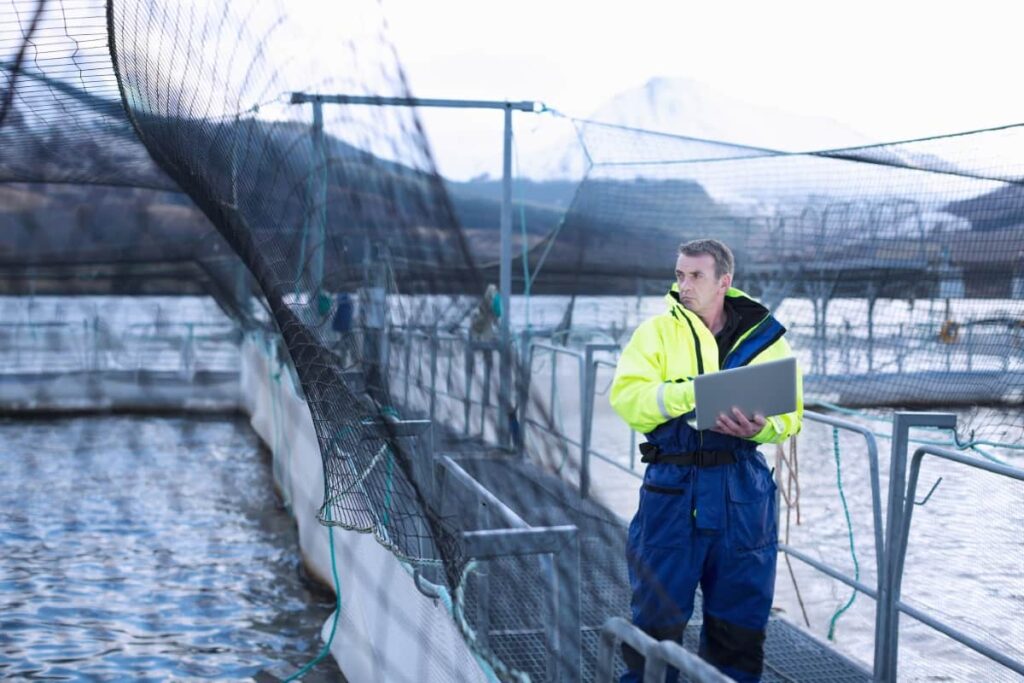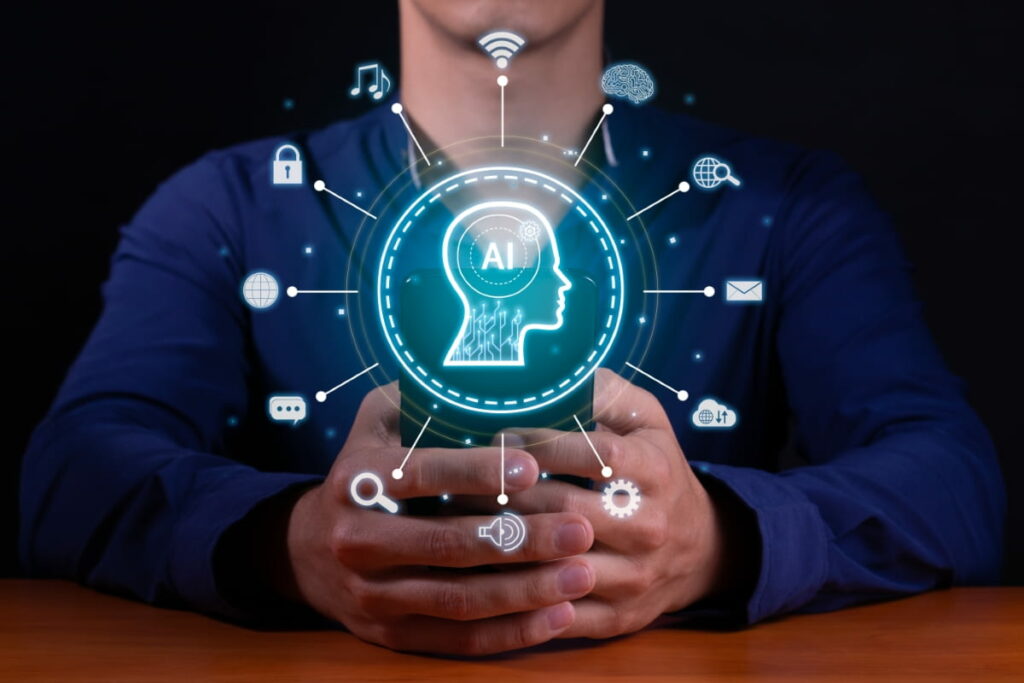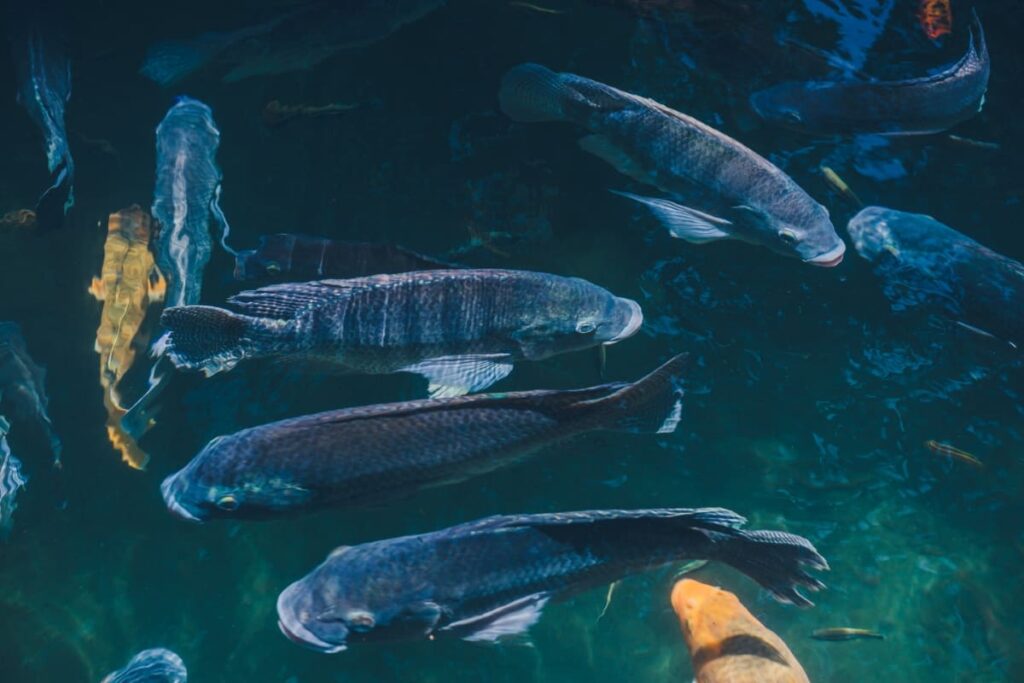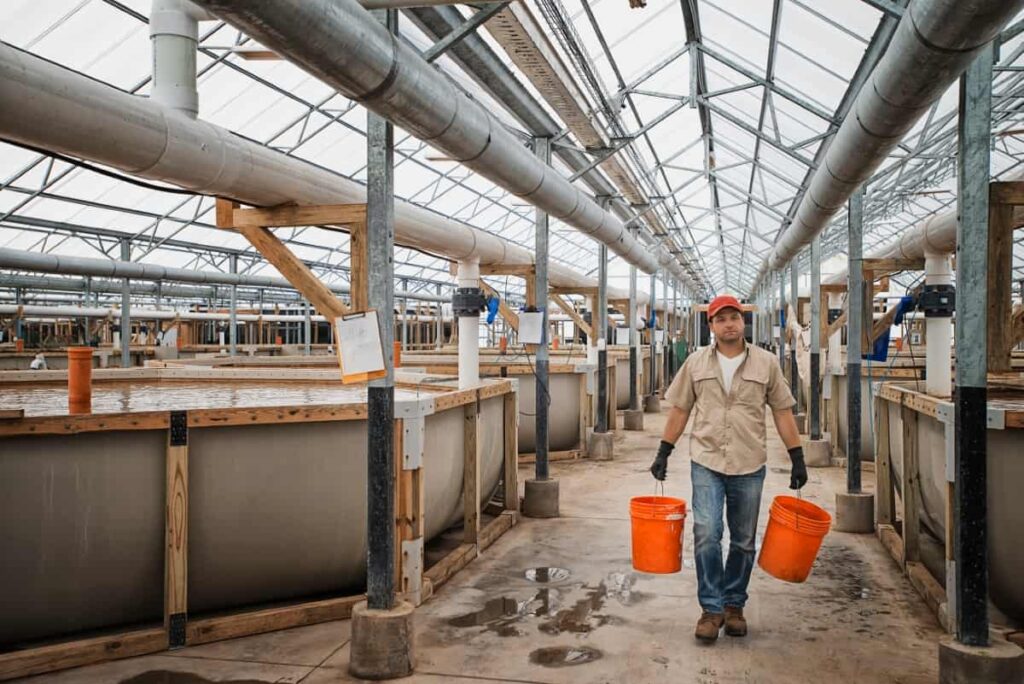AI in Aquaculture refers to the implementation of Artificial Intelligence technology in the fisheries industry. It is revolutionizing the way fish are bred, monitored, and harvested. AI utilizes advanced algorithms and machine learning practices to analyze and make intelligent decisions. In recent years, there has been a significant rise in the use of AI in aquaculture, revolutionizing traditional practices and leading to more efficient and sustainable fish farming.

The Rise of AI in Aquaculture
AI-Driven Precision Aquafarming
It is revolutionizing the way fish are bred and cultivated in aquaculture. Using advanced artificial intelligence algorithms, this innovative approach optimizes every aspect of fish farming to ensure maximum efficiency and productivity. By collecting data from sensors, AI systems can analyze factors such as temperature, oxygen levels, pH balance, and ammonia concentration in real time.
Another important application of AI in precision aquafarming is feed management. Through machine learning algorithms, AI systems can analyze feeding patterns and identify optimal feeding times and quantities for different species at various life stages. Furthermore, AI-driven precision aquafarming utilizes computer vision technology to monitor individual fish behavior and health status.
AI-Powered Fish Health Management
Fish health is of utmost importance in the aquaculture industry. With the rise of artificial intelligence (AI), fish farmers now have access to advanced systems that can help monitor the health of their aquatic stock.
The main role of AI in aquaculture is to analyze vast amounts of data, including water quality parameters, feeding patterns, and fish behavior, to detect early signs of diseases or abnormalities. By continuously monitoring these factors, farmers can take proactive measures to prevent outbreaks or minimize their impact. Moreover, AI-based predictive models are being developed to forecast disease outbreaks based on historical data patterns.
Smart Feeding Systems
These innovative technologies utilize artificial intelligence to optimize feeding practices and improve overall productivity in fish farms. Traditional methods of feeding often involve manual labor and guesswork, leading to inefficiencies and potential health risks for the fish. However, with AI-powered smart feeding systems, farmers can now monitor and automate the entire process with precision.
These systems rely on advanced sensors that continuously collect data on water quality, temperature, oxygen levels, and other critical parameters. Smart feeding systems empowered by artificial intelligence offer immense potential for improving efficiency in fisheries by optimizing nutrition intake while reducing waste output.
Robotics and Automation in Fish Harvesting
With the rise of AI (artificial intelligence) in aquaculture, robotics, and automation are playing a crucial role in fish harvesting processes. Traditionally, fish harvesting has been a labor-intensive task that requires manual laborers to catch fish from ponds or cages. One example of robotics and automation in fish harvesting is the use of underwater drones equipped with cameras and sensors. These drones can navigate through water bodies to locate schools of fish accurately. They can also monitor environmental conditions such as water temperature and oxygen levels for optimal fish health.
In case you missed it: 15 Steps to Start Biofloc Fish Farming: Biofloc Fish Culture Cost, Profit, and Training

These systems ensure that each fish receives an adequate amount of food, promoting healthy growth while minimizing waste. Furthermore, autonomous underwater vehicles (AUVs) equipped with AI-driven navigation systems can help harvesters effectively survey large areas for fishing grounds. These AUVs collect data about ocean currents, seabed topography, and marine life distribution to optimize fishing efforts.
AI in Aquaculture Supply Chain Optimization
From monitoring water quality and temperature to tracking inventory levels and predicting demand patterns, AI enables aquaculture businesses to make informed decisions that streamline operations and reduce costs. By analyzing historical data and current conditions, artificial intelligence in aquaculture can identify optimal transportation routes, minimize travel time, and maximize efficiency.
Another critical aspect that AI addresses is inventory management. Moreover, AI can also enhance traceability throughout the supply chain. By leveraging technologies like blockchain, it becomes possible to track every step of a seafood product’s journey from farm to table accurately.
Types of AI in Aquaculture
One type of AI in aquaculture is machine learning, which involves training algorithms to analyze large sets of data and make decisions based on patterns. Machine learning is used to monitor water quality, predict disease outbreaks, and optimize feeding strategies for fish. Another type of AI technology used in aquaculture is computer vision.
This involves using cameras or sensors to capture images or videos of fish behavior, growth rates, and health conditions. Computer vision systems can detect abnormalities such as lesions or parasites on fish skin and identify individual fish for monitoring purposes. Robotics is another area where AI is making significant strides in aquaculture. A
utonomous underwater vehicles (AUVs) equipped with cameras and sensors can collect data on water quality parameters, while automated feeders ensure precise feeding schedules for optimal growth. Predictive analytics uses historical data combined with machine learning algorithms to forecast future trends or events within the industry. This allows farmers to plan for factors such as market demand fluctuations or environmental changes that may impact production.
Environmental Monitoring with AI
With increasing concerns about water quality, pollution, and climate change, it has become crucial for the fisheries industry to adopt effective environmental monitoring techniques. This is where AI comes into play. AI can analyze data collected from sensors placed in aquaculture facilities or even drones flying over open waters.
These systems can detect changes in water temperature, salinity levels, dissolved oxygen content, and other important parameters that affect aquatic life. By continuously monitoring these factors, AI algorithms can identify potential threats or anomalies that may harm fish populations. Furthermore, AI tools can also assess the impact of aquaculture facilities on their ecosystems.
Data-Driven Aquaculture Practices
Data-driven aquaculture practices harness the power of artificial intelligence (AI) to collect, analyze, and interpret vast amounts of information. The aspect of data-driven aquaculture is real-time monitoring. Sensors placed in tanks or cages can gather data on water quality parameters like pH levels, temperature, oxygen levels, and salinity.
In case you missed it: Fish Pond Size Calculator: Ideal Pond Size for 1000, 5000, and 10,000 Fish

Another important application of data-driven aquaculture is predictive analytics. By analyzing historical data along with environmental factors like weather patterns and feed composition, AI systems can predict growth rates, feeding schedules, disease outbreaks, and even market demand.
AI for Breeding and Genetic Improvement in Aquaculture
By analyzing genetic data, AI algorithms can identify key markers associated with desirable traits like growth rate, disease resistance, and feed conversion efficiency. This allows breeders to select individuals with the highest potential for passing on these favorable traits to future generations. Furthermore, AI-powered systems can also predict the performance of different crosses or combinations of species.
By simulating thousands of potential breeding scenarios, researchers can determine which pairings are likely to produce offspring with superior characteristics. Machine learning can analyze real-time data from sensors placed within aquaculture facilities to detect early signs of disease or stress. Moreover, AI helps optimize feeding strategies by taking into account various factors such as water quality parameters, fish behavior patterns, and nutritional requirements.
Frequently Asked Questions (FAQ) on AI in Aquaculture
What Exactly is AI in aquaculture?
In aquaculture, AI, or Artificial Intelligence, refers to the use of advanced technologies to analyze and process large amounts of data collected from fish farms. This allows for real-time monitoring and decision-making, optimizing operations, and maximizing productivity.
How Does AI Improve Fisheries Management?
By analyzing data on factors such as water quality, feeding patterns, and disease outbreaks, AI can help identify patterns that may not be easily noticeable to humans alone. This enables proactive measures to be taken in areas like feed optimization, disease prevention, and environmental impact reduction.
Can AI Enhance Fish Health and Welfare?
Absolutely. Through sophisticated sensors and machine learning algorithms, AI can monitor individual fish behavior closely. It can detect signs of stress or illness early on, allowing for timely intervention before it spreads within the population.
In case you missed it: Fish Farming in Thailand: Requirements, Types of Fish, and Government Support

Conclusion
In aquaculture, AI can play a crucial role in various aspects such as precision farming, fish health management, feeding systems, harvesting processes, supply chain optimization, environmental monitoring, data-driven practices, breeding programs, and genetic improvement. AI also plays a significant role in smart feeding systems by analyzing feed consumption patterns and fish growth rates and adjusting feed quantity accordingly.
- Management Pests and Diseases in Your Cotton Field
- Sheep Farming Business Plan for Beginners
- Aquaponic Farming at Home: A Step-By-Step Guide
- Profitable Village Farming Business Ideas in 2024
- High-Yield Aquaculture: Fast-Growing Fish for Farming
- Effective Fish Pond Construction Techniques for Beginners
- Irrigation and Water Management in Pineapple Farming
- Blossom to Harvest: Mastering Flowering and Pollination in Papaya Farming
- Pig Fattening Essentials: From Selection to Sale for Beginners
